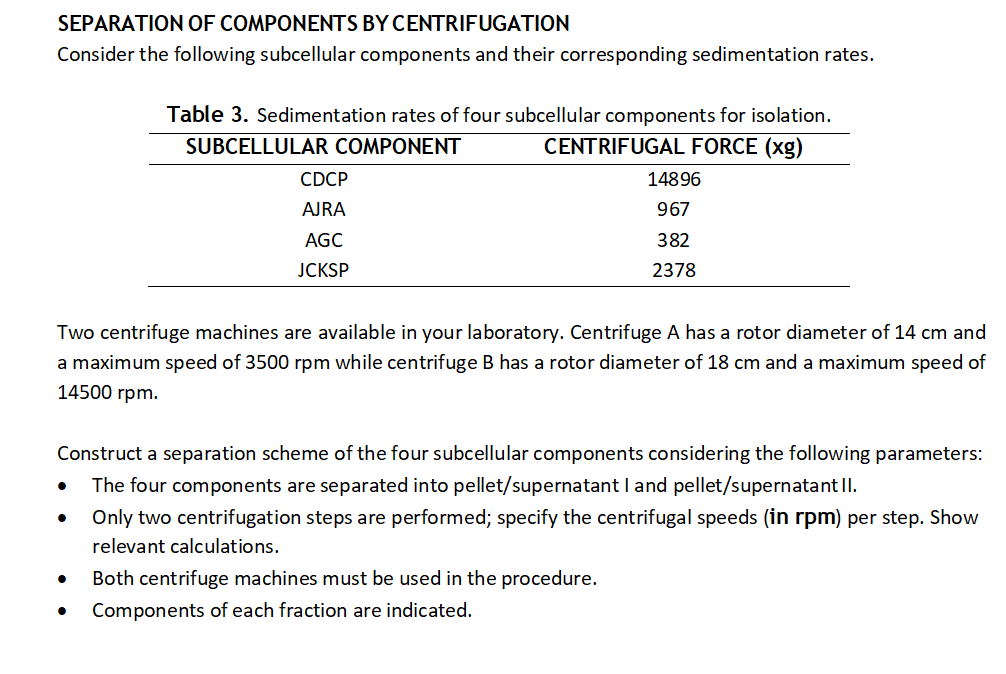SEPARATION OF COMPONENTS BY CENTRIFUGATION Consider the following subcellular components and their corresponding sedimentation rates. Table 3. Sedimentation rates of four subcellular components for isolation. CENTRIFUGAL FORCE (xg) SUBCELLULAR COMPONENT CDCP 14896 AJRA 967 AGC 382 JCKSP 2378 Two centrifuge machines are available in your laboratory. Centrifuge A has a rotor diameter of 14 cm and a maximum speed of 3500 rpm while centrifuge B has a rotor diameter of 18 cm and a maximum speed of 14500 rpm. Construct a separation scheme of the four subcellular components considering the following parameters: The four components are separated into pellet/supernatant I and pellet/supernatant II. Only two centrifugation steps are performed; specify the centrifugal speeds (in rpm) per step. Show relevant calculations. Both centrifuge machines must be used in the procedure. Components of each fraction are indicated.
SEPARATION OF COMPONENTS BY CENTRIFUGATION Consider the following subcellular components and their corresponding sedimentation rates. Table 3. Sedimentation rates of four subcellular components for isolation. CENTRIFUGAL FORCE (xg) SUBCELLULAR COMPONENT CDCP 14896 AJRA 967 AGC 382 JCKSP 2378 Two centrifuge machines are available in your laboratory. Centrifuge A has a rotor diameter of 14 cm and a maximum speed of 3500 rpm while centrifuge B has a rotor diameter of 18 cm and a maximum speed of 14500 rpm. Construct a separation scheme of the four subcellular components considering the following parameters: The four components are separated into pellet/supernatant I and pellet/supernatant II. Only two centrifugation steps are performed; specify the centrifugal speeds (in rpm) per step. Show relevant calculations. Both centrifuge machines must be used in the procedure. Components of each fraction are indicated.
Chapter2: Aquatic Plants And Animals
Section: Chapter Questions
Problem 2KA
Related questions
Question

Transcribed Image Text:SEPARATION OF COMPONENTS BY CENTRIFUGATION
Consider the following subcellular components and their corresponding sedimentation rates.
Table 3. Sedimentation rates of four subcellular components for isolation.
CENTRIFUGAL FORCE (xg)
SUBCELLULAR COMPONENT
CDCP
14896
AJRA
967
AGC
382
JCKSP
2378
Two centrifuge machines are available in your laboratory. Centrifuge A has a rotor diameter of 14 cm and
a maximum speed of 3500 rpm while centrifuge B has a rotor diameter of 18 cm and a maximum speed of
14500 rpm.
Construct a separation scheme of the four subcellular components considering the following parameters:
The four components are separated into pellet/supernatant I and pellet/supernatant II.
Only two centrifugation steps are performed; specify the centrifugal speeds (in rpm) per step. Show
relevant calculations.
Both centrifuge machines must be used in the procedure.
Components of each fraction are indicated.
Expert Solution
This question has been solved!
Explore an expertly crafted, step-by-step solution for a thorough understanding of key concepts.
Step by step
Solved in 3 steps

Recommended textbooks for you

